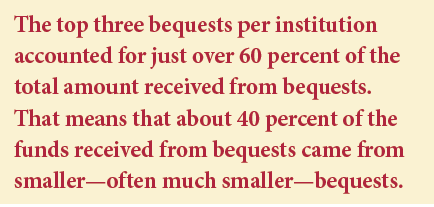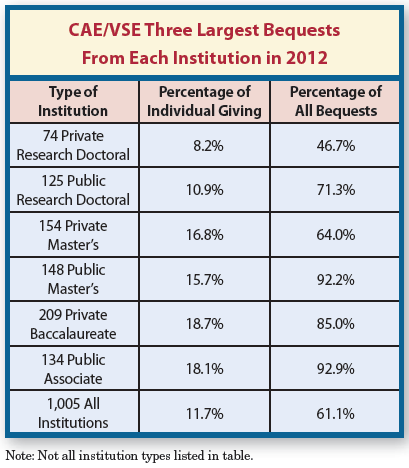In the July issue of Give & Take, we examined the rebound of charitable trusts and other deferred gifts to higher education revealed in the 2012 Voluntary Support of Education (VSE) report. Each year, the Council for Aid to Education (CAE) conducts this survey of educational institutions and provides an authoritative report of its findings.
With approximately 1,000 institutions of higher learning participating in the survey each year, there is a wealth of information from a variety of sources. Realized bequest amounts and the number and amount of other deferred gifts are included as research data points and are analyzed as a component of all individual giving.
Impact of bequests
Over the past decade, VSE survey respondents have reported a total of just under $26 billion in charitable bequest distributions. That figure represents 11 percent of the $226 billion in total bequests reported by Giving USA for the period. Bequest totals over the past decade amount to 23 percent of all individual giving to higher education.

The 2012 VSE survey data was received from nearly all institutions actively involved in fundraising and showed that the total received from each institution’s three largest bequests accounted for 11.7 percent of all individual giving. Further, the three largest bequests also represented 61.1 percent of the total amount received from bequests.
Depending on the type of educational institution, the top three bequests represented anywhere from 8.2 percent to 18.7 percent of all individual giving. The three largest bequests also accounted for varying percentages of the amount received from bequests alone, ranging from 46.7 percent to 92.9 percent. See chart below.

How large bequests affect totals
The role bequests play in gift planning may be summarized as the impact of the few and the importance of the many.
While these observations may seem to be at odds, they are actually complementary. Consider the information learned from survey respondents in this year’s report. The top three bequests per institution accounted for just over 60 percent of the total amount received from bequests. That means that about 40 percent of the funds received from bequests came from smaller—often much smaller—bequests.
Put another way, it appears that a small number of large bequests provide the majority of bequest revenue each year, but a large number of smaller bequests also provide a significant portion of bequest revenue. The Sharpe Group’s analysis of VSE data in comparison to the Sharpe KnowledgeBase reveals that the institutions that had smaller percentages from the top three bequests also had more successful programs overall and had engaged in broad-based efforts to encourage bequests and other planned gifts over time.
Don’t overlook the many
Gift planners may wish to devote additional time and resources to stewardship of older, wealthier prospective donors who have the capacity to make significant bequests. But they should also make sure that they have plans in place to inform, educate and motivate the larger numbers of older donors who could leave an average or median-sized bequest. Seeking a large number of relatively small bequests has proven to be a wise use of resources in addition to seeking larger bequest gifts from donors who may be considered statistical outliers.

For example, suppose an institution received $10 million in bequests last year, but 80 percent ($8 million) of that amount came from its top three bequests. If the institution also devoted resources to encouraging bequests from a broader range of donors, it would hope to reach the ideal point of having closer to 50 percent of its bequest revenue coming from the top three bequests and could expect to receive a total of $16 million in bequests. Failure to encourage broader-based bequests could in this case “cost” the institution $6 million in lost bequests, some 38 percent of its potential. In the Sharpe Group’s experience, the most successful programs are, in fact, receiving in the range of 50 percent of bequests from a broader group and are consistently outperforming their peers.
If you would like help reviewing your program structure or marketing plan, simply contact us at info@sharpenet.com or 901-680-5300.

